| |
|
SPACE INVADERS
Although Taito had the right idea, they didn't put enough work into their first Game Boy conversion of Space Invaders to really capture the attention of a new, more demanding generation of gamers. There are two major problems with this port... the first is that there aren't any new modes or features to help ease Nintendo fans into the straightforward gameplay. Players from the late 1980's expected power-ups and screen-filling bosses from their games, and Space Invaders on the Game Boy just doesn't offer them. The second issue is that, as a straight conversion of Space Invaders, it's just not very good. Inaccuracies abound in the translation... the army of invaders have been pared down from an intimidating fifty-five to a less threatening forty, and all the aliens have been redrawn, so that the invaders on the top rows are just as wide as the ones near the bottom. Believe it or not, even the animation has taken a hit... beams dropped from the fiends above don't ripple as they fall, choosing instead to stay frozen in the same frame of animation as they streak toward your ship. Then there's the sound, which is less surprising considering the Game Boy's limitations, but just as disappointing. The march of the invaders is as good as one could expect from the Game Boy, but other effects like the firing of your cannon aren't acceptable by even the lowest standards. Your cannon's blast of destructive energy sounds more like the blast of steam coming from an old clothes iron. Other effects, like the explosions of the invaders and your own tank, are equally unimpressive, limiting the game's appeal to... well, to be honest, I can't imagine anyone actually wanting this. Even Taito was so underwhelmed by the final product that it decided its first shot at Space Invaders on the Game Boy was unfit for American consumption. After an uncharitable review of the game was printed in EGM, the US release of Space Invaders was cancelled, and Taito decided to wait a couple of years until it had something better to offer this country's fans of Space Invaders. SPACE INVADERS
'91
The basic gameplay in Space Invaders '91 closely mirrors that of the ancient arcade game. Hostile aliens march across the screen, hoping to land on your home planet, and it's your job to make sure they never get there, by blasting them out of the sky as they close in on your territory. Unlike Galaga '88 or even Return of the Invaders, the enemy formations and attack patterns aren't particularly fancy... the invaders just march from one end of the screen to the other, then drop down about an inch and reverse direction. This doesn't sound like it would be all that exciting, but this seemingly simplistic gameplay offers the player a whole lot of strategic possibilities thanks to a wide variety of power-ups. If you can strike the UFO at the top of the screen as it flies by, you can collect weapons ranging from homing bullets to vertical lasers. These weapons can be used to lay waste to your enemies, but it's best to hold onto them for the right occasion. For instance, the homing bullets are guaranteed to hit their targets, but if you use them to nail the aliens in the first two rows, their friends will speed up, closing the gap between themselves and your ship much more quickly. It's far wiser to save the bullets until only a few invaders are left... this way, you can finish them off with ease no matter how quickly they race toward the planet's surface. Every time you successfully defend a planet from two alien encounters, you'll move to a new location, closer to the invaders' base of operations. Each new stage features environmental hazards which add further depth to the gameplay. One planet has an enormous crater which affects the aim of your laser cannon as it makes its way down and over its convex surface. Another has space debris which blocks the shots of both your cannon and the enemies... fire enough times and the abandoned space ships crash to Earth, blocking your path. There's even a gigantic cavern with "crags", heavy stalagtites which threaten to break free from their perch at the top of the screen and crush your ship if you're careless with your fire. There's a lot more depth in Space Invaders '91 than in the first game, but that's not all the designers have added. Both the graphics and sound have been greatly improved... each world has its own type of invader, and they spin, pulsate, and twitch as they descend on the planet's picturesque surface. The soundtrack is even better, pushing the limits of the Genesis sound processor with well-written, atmospheric tracks which set the mood for every planet you'll visit. The game's only real flaw is that it's, well, Space Invaders. It just doesn't offer the variety, the intense gameplay, or the dynamic level design of other shooters on the Genesis. Still, if you're a fan of the series, it doesn't get much better than Space Invaders '91. SPACE INVADERS: FUKKATSU
NO HI
It sounds like PC Engine owners got the better end of this deal, but when you actually play the game, you quickly realize that they were the ones who got the shaft. Fukkatsu No Hi is a competant Space Invaders remake, but it doesn't get your blood flowing the way that its Genesis counterpart does. There are several reasons for this... first of all, the graphics are kind of dull, especially when you consider the PC Engine's robust color palette. You'd think the invaders would leap off the screen and the playfields would offer plenty of depth and detail, but everything is surprisingly flat. This is in sharp contrast to Space Invaders '91, which makes the most of the Genesis's limited color output. There are some inventive special effects... for instance, invaders struck by your beam are violently thrown out of formation, bleeding yellow goo from your shot's point of impact just before they vanish. Even with added touches like these, Fukkatsu no Hi is the least attractive of the two games. The music is also noticably more rough on the PC Engine, with high-pitched, digital tones that lack the depth of the multiple instruments in Space Invaders '91. You can tell the designers were trying their best... the soundtrack has a peppy, upbeat style which will sound familiar to fans of Japanese science-fiction cartoons. Unfortunately, the limitations of the system's sound processor prevent this well-written music from reaching its full potential. Finally, there's the matter of the gameplay. It's competant, sure, but with the PC Engine game you just feel like there's something missing. Less demanding requirements for collecting power-ups would certainly have been nice... merely winging the saucer as it flies by isn't enough to claim its prize. You must strike the UFO directly in its center, which is a tall order when you consider that you'll also be dealing with a lynch mob of angry aliens while lining up this incredibly difficult shot. Did I mention just how aggressive the invaders are in Fukkatsu no Hi? They lay down some serious firepower, spitting out an abundance of beams and bullets that are larger and tougher to avoid than the ones in Space Invaders '91. Fukkatsu no Hi does offer some advantages over its Genesis counterpart, like a port of the original Space Invaders (quite faithful to the original, despite subpar sound effects) and a flashy opener, featuring your ship rendered in stylish vector graphics. In the end, though, it's Space Invaders '91 that takes home the prize for the best 16-bit revival of this classic series. SUPER SPACE INVADERS
'91
While these bonus rounds aren't quite up to the standards of the mesmerizing Galactic Dancing stages in the Galaga series, they're still a fun break from the rest of the game, with a completely different style of gameplay and a tounge-in-cheek approach to the alien invasion storyline. The Cattle Mutilation rounds were also an indication of where Taito would take the series... years after Majestic Twelve hit arcades, Taito softened the hard-edged gameplay of Space Invaders with wacky parodies like Akkanvaders (aka Space Invaders '95: Attack of the Lunar Loonies), and even had characters from the original game make cameo appearances in the Japanese Saturn release Bubble Symphony.
SUPER
SPACE INVADERS
I'll specifically be reviewing the x86 PC and Game Gear versions of Super Space Invaders. They're both strong translations of the arcade game, weighed down only slightly by a heavy British influence in the design. This is especially true in the case of the PC game... the metallic status bars running along the sides of the screen and the redrawn invaders make it clear that the designers took some very European artistic liberties with the arcade game. Of course, there are times when the game's British heritage actually add to its appeal... there's a fantastic cartoon intro in the PC version of the game that you won't find anywhere else, along with a silly storyline where the Space Invaders coin-op inspires a real-life alien attack in the distant future. Hey, it's no more ridiculous than hostile intergalactic beings invading our home planet... only to die moments later from exposure to common germs or even worse, drops of rain. Have any of these supposedly advanced races ever heard of space suits? Yeesh. But er, back to the review. The Game Gear version isn't nearly as impressive as its big brother on PCs... the invaders have been shrunken down to nearly microscopic size, and the color is more garish, despite the Game Gear's more robust color palette (the PC game uses an EGA display which limits it to just sixteen colors). Also, if you're looking for the great animated opener, forget about it... all they managed to squeeze into the handheld version were still screens taken from the cartoon. Despite everything that's been taken out, there's still a pretty good game left. The aliens still have all their clever attack formations and strategies, like the sweeping circular flight patterns and the invaders that bloat to twice their original size when hit. The power-ups are still here, including the time stop which freezes your foes in place and the barriers which soak up some of the invaders' deadly rain of fire. The only thing about the gameplay that's been compromised are the boss fights... their weaknesses are more difficult to exploit, and the homing missiles they send after you are too accurate, making them almost impossible to avoid. Super Space Invaders on the Game Gear has flaws, but its variety and colorful graphics make it far preferable to Taito's lackluster conversions of the first game on the Game Boy. As for the PC game, it shouldn't be too tough for you to find if you've had any past experience hunting down abandonware. Just be warned that it's a very old game, designed for far less advanced computers than the one you're using to read this page. Super Space Invaders runs at a consistent speed on my Athlon XP (roughly 1.5 gigahertz, with Windows 2000 as the default operating system), but your mileage may vary.
SPACE
INVADERS
This popular Super NES peripheral made playing many Game Boy games a lot more fun, letting you enjoy them on a full-sized screen, using a full-sized controller. However, there were only a few instances where the add-on would actually enhance the games themselves. Space Invaders was one of the rare games that took full advantage of its Super Game Boy compatibility. And just how do these exclusive features enhance the game? Well, for starters, there's a stylish border that reproduces the cabinet artwork of the arcade version of Space Invaders. This, along with the multiple color options you can select, gives the game a more authentic feel, which helps make up for the smaller number of onscreen invaders. If even this isn't enough to create a convincing arcade atmosphere, you can skip the Game Boy game entirely and boot up a Space Invaders conversion written specifically for the Super NES. This translation would later be released as a standalone Super Nintendo cartridge, but if you own the Game Boy game, you won't need it. You've already got two great ports of Space Invaders for one great low price! SPACE INVADERS
DX
In this mode, both the laser cannon and the invaders have been replaced with characters from less successful Taito creations, ranging from the cutesy side-scrolling platformer The New Zealand Story (shown here) to that most beloved of classics, Bubble Bobble. Also represented is the horrid Bubble Bobble wanna-bee Fairyland Story, an early and rather unfortunate Taito release which most accurately reflects the quality of the Parody Game. Even with the glossy graphics and a wider selection of enemies, it just isn't as fun as the straight conversions of Space Invaders offered in this collection. The characters are so tiny and so aggressive that it's tough to line up shots without getting blasted yourself. The rest of Space Invaders DX is great, if you're expecting nothing more than faithful reproductions of the arcade game from 1978. However, the Parody Game is such a disaster that it's obvious why Taito swept it under the rug when they ported DX to the Super NES. SPACE INVADERS '95: ATTACK OF THE LUNAR
LOONIES
At its core, Attack of the Lunar Loonies is a Space Invaders game, enhanced with all the innovations of the more recent games in the series. It's got the power-ups from Space Invaders '91, along with the bosses and more imaginative invader formations from Super Space Invaders. Attack of the Lunar Loonies also throws in some improvements of its own for good measure... there's a selection of characters to choose from, each with their own unique abilities, and you can charge up shots to take out that last pesky space soldier as he darts his way across the screen. As good as it is, it's not the core gameplay that makes Attack of the Lunar Loonies special. It's the crazy characters and the clever sight gags that put this one over the top. The game starts out with rows of the invaders from the first game... but after a few seconds, they transform into a silly assortment of bald ladies and pink octopi. As the intruders close in on your planet, they perform an accapella version of the Space Invaders marching sound, calling out "Wah, wah, wah, WAH!" with every step! After a while, the UFO flies by... but this time, it's piloted by a pig delivering a package. Nail the porcine porter as he makes his way across the screen, and he drops his prize, an enormous bowling ball. Grab it and you can send the ball right back to the invaders... when it collides with them, you'll hear the satisfying crash of pins as they wildly scatter in every direction. It's this kind of ingenius insanity that makes you look forward to each new stage, along with the bosses waiting at the end of each one. There are some really memorable moments here, like the encounter with the world's sexiest hermit crab (seriously, she looks like she'd be living in the Playboy mansion if Hugh Hefner had a thing for crustaceans) and the battle against a boatload of seafood, one of Taito's many tounge-in-cheek references to the fish-filled shooter Darius. When this huge battleship approaches, you'll be tempted to meet it with a pair of chopsticks in one hand and a bottle of soy sauce in the other! The graphics in Attack of the Lunar Loonies are fantastic... the backgrounds as surreal as they are brightly colored, with oceans of milk flowing around mountains of cookies and enormous blue spaceships that look like they just rolled off a Cadillac assembly line. The characters are just as well done... they're large, well animated, and impressively detailed, especially the gorgeous bosses. As for the sound, it's Zuntata's typically outstanding work, with an appropriately lighthearted tone that will remind you of the music in the Bust-A-Move games. The sound effects are divided evenly between the familiar chirps and explosions of the original Space Invaders, and the comical Japanese voices you'd expect from a game inspired by Konami's Paradious. Attack of the Lunar Loonies' only shortcoming is that it, like most of the other Space Invaders games, gets repetitive quickly. The demented humor and unpredictable new enemy patterns keep the monotony to a minimum, but by the time you've finished the game you'll be glad it's over. At the same time, you'll be just as happy that you spent that hour playing it.
SPACE INVADERS: THE
ORIGINAL GAME
Like the arcade game, Space Invaders on the Super NES is a remake of the 1978 original. There aren't any bosses, or power-ups, or hidden secrets... just the straight out invader blastin' action that most players have known from birth. There ARE graphic enhancements, however. You can select from several game modes which reproduce the various displays used in the arcade game. In addition to the standard monochrome and color modes, there's an overlay, which covers the screen with multicolored stripes that tint the invaders in shades of red and blue, and a moon background which makes excellent use of the Super Nintendo's hardware transparency. You can actually see the background behind the character sprites, adding a touch of high-tech class to the classic gameplay. You can also play a special versus mode which pits you against a friend in a split-screen battle to the death. Although you can't fire at your opponent, you can do just as much damage by targetting the colored aliens hiding in your invader formation. This subjects the other player to a variety of nasty setbacks... their own fleet of cosmic creeps could drop a row, or you may transfer a row of your invaders to their side of the screen. Be careful, though... you could also switch formations entirely, which could come to your advantage or spell your doom depending on the other player's current situation. Space Invaders: The Original Game is a strong conversion of the 1978 arcade game, but it's kind of a letdown when you consider just how much of the Super Nintendo's capabilities were left untapped. Taito would have been a lot smarter to bring Attack of the Lunar Loonies to the system instead... its vividly colored backgrounds, hilarious characters, and more advanced gameplay would have been right at home on the Super NES. Besides, with a Super Nintendo version of Space Invaders already included as a hidden bonus on Nintendo's Game Boy game, this second release just seems redundant. SPACE INVADERS: VIRTUAL
COLLECTION
These days, Space Invaders: Virtual Collection sells for hundreds of dollars on auction sites like eBay, and nobody has been willing to share the game with the world by publicly distributing the ROM. It's kind of a shame, because it would be worth playing for its novelty value alone. Space Invaders: Virtual Collection taps the power of the Virtual Boy by offering an exclusive 3D version of the game, where the invaders are set on a slanted playfield and grow in size as they close in on you. I'm not aware of any other enhancements beside this special effect, but hey, even a straight conversion of Space Invaders has got to be better than nearly everything else in the Virtual Boy's software library. SPACE INVADERS
There IS one thing that seperates the Saturn version of Space Invaders from all the others you've seen. The versus mode's been given an overhaul, with improved artwork and the chance to interact with your opponent. This time, you can fire at the other player, blowing them to smithereens and robbing them of a few precious seconds as their set of invaders get closer and closer. I wish there was more to the game than this, I really do. Taito could have put all the empty space on the disc (and there's a whoooole lot of it) to good use with a conversion of Attack of the Lunar Loonies, or even Space Invaders '91 on the Genesis. Instead, all we get is plain old Space Invaders. The only thing harder for me to comprehend than Taito releasing this bare-bones game for such an advanced system is the thought of someone actually BUYING it.
SPACE INVADERS
SPACE INVADERS
Activision, another influential game manufacturer with deep roots in the industry, was one such company. They secured the rights to develop a modern update of Space Invaders on the Playstation and Nintendo 64. Activision decided that their game would play much like the original released in 1978, but that it would take advantage of the exciting new capabilities offered by these next generation game systems. The stiff, monochrome invaders would be replaced with more dynamic polygonal creatures, menacingly dangling their claws as they hung above your ship like a flock of hungry vultures. The black backgrounds would be enhanced with computer rendered planetscapes and colorful fields of stars. Finally, the monotonous gameplay would be improved with power-ups, earned both from the UFOs and by striking chains of like-colored invaders. Past evolutions of Space Invaders have done wonders for the series, making it more fun and addictive without compromising the core gameplay. With this in mind, you'd think that Activision's Space Invaders would be the best version of the game yet. Sadly, things just don't work out that way. This modern update lacks the charm and structure of the Japanese games, designed by the creators of the series. Out of all the game's flaws, the worst is that it's just not that much fun. Space Invaders for the Nintendo 64 has an uneven difficulty level... the battles against invaders are much too easy, while the boss encounters at the end of each planet are ridiculously unfair. You'll find yourself racking up points and lives without breaking a sweat, only to lose them all when you square off against an enormous ship which sprays the screen with bullets and slams your laser cannon with its gigantic body. Tough bosses aren't that unusual in a shooter, but it IS kind of strange that the first one in Space Invaders is perhaps the hardest in the entire game. Half the time, it's so close to the bottom of the screen that you've got no hope of avoiding it! Fortunately, you won't be dealing with these bosses most of the time. UNfortunately, all that time will be spent picking off invaders who don't put up much of a fight. They'll even help you finish them off by giving you overpowered weapons... simply nail four like-colored space soldiers in a row, and you'll be given an attack that can wipe out entire rows or columns of enemies. Even if you can't get these weapons, you can wipe out invaders with ease by simply nudging one of your barriers up toward them. Instead of chewing through the shields like in previous games, the aliens simply explode after colliding with them. Even the UFOs will aid in the destruction of their race by dropping helpful items like the double shot (helping you clear the screen of foes twice as quickly) and the shield (which protects you in the unlikely event that you're actually hit by a bullet). Speaking of flying saucers, there's a bonus stage halfway through each level that seems more like a chore than a challenge. The UFOs here lazily float across the sky in a straight path, making them easy targets for your cannon. There's no touch of humor like in Super Space Invaders' Cattle Mutilation rounds, or any bewildering flight patterns like the ones in Attack of the Lunar Loonies. It's just more boredom in a game that's already chock full of it. Even the advanced graphics and sound are nothing exceptional. The game pushes a lot of polygons, but you won't be too impressed when you see what's been done with them. The invaders are spastically flailing, abstractly shaped creatures that look nothing like the aliens in Taito's games... or for that matter, anything else. Are they spaceships? Are they organic lifeforms? Is there anything that makes them dangerous aside from all those pointy limbs? The soundtrack is less thought-provoking... in fact, you won't be thinking much about the game's generic techno music at all. Like the other classic game revivals on the Playstation and Nintendo 64, it's hard to consider Space Invaders a legitimate extension of the series. It's not as awful as Frogger or Pong, but that's part of the problem... it's so completely unremarkable that it's not even good at being bad. SPACE INVADERS X
What makes this Space Invaders revival better than its 32-bit and 64-bit cousins? Let's see... well, the graphics are crisp and clean, rather than dark and muddy. The invaders are bursting with color, a sharp contrast to the primitively drawn sprites in far too many Game Boy Color titles. There's also a wonderfully campy soundtrack inspired by science-fiction movies from the 1950's (there's no better music for a game about an alien invasion). Finally, the action demands as much from you as it does the humble Game Boy Color. The alien forces never let up, dropping missiles and bombs without triggering even a little slowdown or flicker. This is quite an accomplishment when you stop and consider the system's many limitations! All right, so that didn't really answer the question. How is Space Invaders on the Game Boy Color better than the Playstation and Nintendo 64 versions? Frankly, it's just more imaginative and fun to play. The weapons that were plain and predictable in the console versions were replaced with power-ups that are both strategically useful and pretty darn cool. There's a Shuriken attack that cleaves the invaders in two, turning the split halves into deadly projectiles. Then there's the Trident, a beam which strikes an invader, then branches off in two directions to dish out even more damage. These weapons will give you an advantage against the swarms of space monsters, but even with them, the game still remains challenging. In fact, as you progress, new invaders will join the fight, each with their own devastating attacks that tilt the odds in the alien armada's favor. Once you're halfway through the game, you'll be thankful you've got a generous supply of shields and the ability to dart across the screen by double tapping left or right on the joypad. Sure, it may just be a Game Boy Color game. Still, you're going to want this alongside all your favorite Game Boy Advance titles, as it's one of the better Space Invaders games... and one of the very best made for a handheld system. The fact that it outperforms both the N64 and Playstation version of Space Invaders says a lot about its quality. SPACE
INVADERS
So you get a pretty good translation of Space Invaders out of this game... but you won't get much more than that. There's a versus mode that makes use of the Wonderswan's link cable, but to take advantage of this, you have to know someone else who owns one. Frankly, just finding an American who knows that a Wonderswan is a game system and not an off brand of laundry detergent would be a challenge. |
|
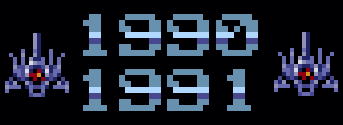
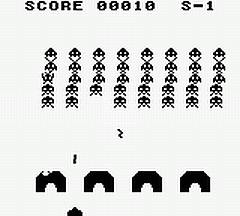 New hardware brings with it revivals of classic video
games... like Space Invaders, for instance. When the Game Boy
was introduced, Taito decided that it would be the perfect time to
take its most famous series out of retirement and into the hands of
players everywhere. It was a smart decision... a game like
Space Invaders, with its simple but addictive gameplay and its
monochrome graphics, was a perfect fit on the humble Game
Boy.
New hardware brings with it revivals of classic video
games... like Space Invaders, for instance. When the Game Boy
was introduced, Taito decided that it would be the perfect time to
take its most famous series out of retirement and into the hands of
players everywhere. It was a smart decision... a game like
Space Invaders, with its simple but addictive gameplay and its
monochrome graphics, was a perfect fit on the humble Game
Boy.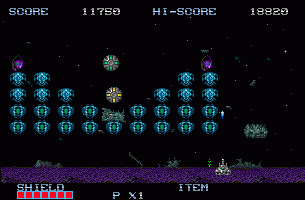 Space Invaders on the
Game Boy wasn't the best first step toward bringing Space Invaders
to a new generation of gamers, but Space Invaders '91 proved that
there was still plenty of life left in the
franchise. Released on the Genesis as Taito's answer to
Namco's own, equally brilliant Galaga '88 (released two years later
on a rival console), Space Invaders '91 was both a true sequel to
the original game introduced in 1978, and one of the better shooters
on Sega's most popular game console.
Space Invaders on the
Game Boy wasn't the best first step toward bringing Space Invaders
to a new generation of gamers, but Space Invaders '91 proved that
there was still plenty of life left in the
franchise. Released on the Genesis as Taito's answer to
Namco's own, equally brilliant Galaga '88 (released two years later
on a rival console), Space Invaders '91 was both a true sequel to
the original game introduced in 1978, and one of the better shooters
on Sega's most popular game console. The PC Engine (known as the
Turbografx-16 in America) was very popular in Japan. The Mega
Drive (our Sega Genesis) was not. Knowing this, Taito offered
the many PC Engine fans a Space Invaders game of their own.
This release, subtitled Fukkatsu No Hi (The Day of Resurrection),
offer the same style of gameplay as Space Invaders '91 on the
Genesis, along with a translation of the original arcade game from
1978.
The PC Engine (known as the
Turbografx-16 in America) was very popular in Japan. The Mega
Drive (our Sega Genesis) was not. Knowing this, Taito offered
the many PC Engine fans a Space Invaders game of their own.
This release, subtitled Fukkatsu No Hi (The Day of Resurrection),
offer the same style of gameplay as Space Invaders '91 on the
Genesis, along with a translation of the original arcade game from
1978.  This game, also known by the
rather cool alternate title Majestic Twelve, introduced a lot of
great new ideas to the Space Invaders series. Out of the many
innovations that Space Invaders '91 brings to the table, the
best feature can be summed up in two words... "Cattle
Mutilation". This bonus round challenges you to protect a
field of cows from fleets of saucers, which dance around the
screen wildly before hovering over the ground and beaming up the
nearest bovine. After a saucer captures a cow, you'll need to
tag the edge of the ship with a bullet to free the hapless heifer
before the saucer flies out of range. You get double the
points for UFOs with cows in tow, and you'll get an even larger
bonus if you can nail the creeps just before they escape.
This game, also known by the
rather cool alternate title Majestic Twelve, introduced a lot of
great new ideas to the Space Invaders series. Out of the many
innovations that Space Invaders '91 brings to the table, the
best feature can be summed up in two words... "Cattle
Mutilation". This bonus round challenges you to protect a
field of cows from fleets of saucers, which dance around the
screen wildly before hovering over the ground and beaming up the
nearest bovine. After a saucer captures a cow, you'll need to
tag the edge of the ship with a bullet to free the hapless heifer
before the saucer flies out of range. You get double the
points for UFOs with cows in tow, and you'll get an even larger
bonus if you can nail the creeps just before they escape.

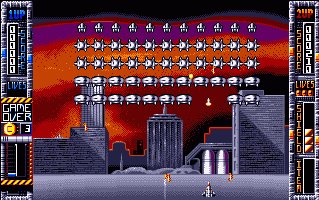 Domark, the European division of Tengen
Games, bought the rights to Super Space Invaders '91 for
distribution on game consoles and home computers. They made
the most of the license, too, releasing the game on every system
that had room for it in its library. Consoles like the
Sega Genesis that already had official Space Invaders games were
left off this long list, but Super Space Invaders did show up on
nearly everything else, from x86 PCs to the Sega Game Gear, along
with British favorites like the Commodore Amiga and the Sega Master
System.
Domark, the European division of Tengen
Games, bought the rights to Super Space Invaders '91 for
distribution on game consoles and home computers. They made
the most of the license, too, releasing the game on every system
that had room for it in its library. Consoles like the
Sega Genesis that already had official Space Invaders games were
left off this long list, but Super Space Invaders did show up on
nearly everything else, from x86 PCs to the Sega Game Gear, along
with British favorites like the Commodore Amiga and the Sega Master
System.
 This Game Boy conversion of Space
Invaders made up for Taito's last one in a big way.
It's more faithful to the arcade game, with better drawn
invaders and stunningly accurate sound effects. Overall, you
get a pretty good experience by playing Space Invaders on a plain
old Game Boy, but things can only get better from there. When
you take the cartridge out of the humble handheld and pop it into a
Super Game Boy, you're suddenly given a lot more options.
This Game Boy conversion of Space
Invaders made up for Taito's last one in a big way.
It's more faithful to the arcade game, with better drawn
invaders and stunningly accurate sound effects. Overall, you
get a pretty good experience by playing Space Invaders on a plain
old Game Boy, but things can only get better from there. When
you take the cartridge out of the humble handheld and pop it into a
Super Game Boy, you're suddenly given a lot more options.
 Much of the content in this
arcade release would eventually find its way on the Super
NES, in the form of Space Invaders: The Original Game.
The only part of Space Invaders DX that didn't make the cut is the
Parody Game, which is less of a parody than a shameless
advertisement for other Taito games.
Much of the content in this
arcade release would eventually find its way on the Super
NES, in the form of Space Invaders: The Original Game.
The only part of Space Invaders DX that didn't make the cut is the
Parody Game, which is less of a parody than a shameless
advertisement for other Taito games.  Satirical space shooters were
all the rage in Japan back in 1994, when Paradious and its sequels
had injected a welcome shot of comic relief into a genre of games
that had become much too predictable. Taito wisely chose
to take its Space Invaders series in the same
direction, lightening the mood with an outrageously funny parody
full of the same warped humor and blindingly bright colors as
Konami's Paradious games.
Satirical space shooters were
all the rage in Japan back in 1994, when Paradious and its sequels
had injected a welcome shot of comic relief into a genre of games
that had become much too predictable. Taito wisely chose
to take its Space Invaders series in the same
direction, lightening the mood with an outrageously funny parody
full of the same warped humor and blindingly bright colors as
Konami's Paradious games.
 Most people don't realize this, but
Space Invaders on the Super Nintendo is actually a conversion of a
much more recent game in the series. It's closely patterned
after the obscure arcade release Space Invaders DX, missing only the
dreadful "Parody Game" that replaced the invaders with other Taito
characters. Trust me, though, you're not going to miss
it.
Most people don't realize this, but
Space Invaders on the Super Nintendo is actually a conversion of a
much more recent game in the series. It's closely patterned
after the obscure arcade release Space Invaders DX, missing only the
dreadful "Parody Game" that replaced the invaders with other Taito
characters. Trust me, though, you're not going to miss
it.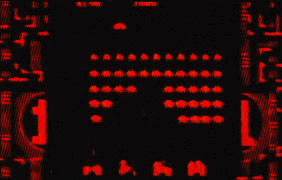 Even the quickly forgotten
Virtual Boy had its turn at bat with the Space Invaders
license. This conversion of the first two Space Invaders
arcade games was only released in Japan, and even there, you would
have been lucky to find a copy.
Even the quickly forgotten
Virtual Boy had its turn at bat with the Space Invaders
license. This conversion of the first two Space Invaders
arcade games was only released in Japan, and even there, you would
have been lucky to find a copy.  Atta way to
half-ass the only version of Space Invaders on the Saturn there,
Taito. When you consider all the great stuff that the company
had released for this system (Bust-A-Move 2, Elevator Action 2
Returns, Bubble Symphony, etc.), you'd think they could have put a
bit more work into this game. Instead, they just
schlepped together yet another port of the endlessly rehashed
Space Invaders DX and called it a day. Great job there,
guys!
Atta way to
half-ass the only version of Space Invaders on the Saturn there,
Taito. When you consider all the great stuff that the company
had released for this system (Bust-A-Move 2, Elevator Action 2
Returns, Bubble Symphony, etc.), you'd think they could have put a
bit more work into this game. Instead, they just
schlepped together yet another port of the endlessly rehashed
Space Invaders DX and called it a day. Great job there,
guys!
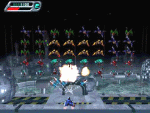 There's really not much I can say about the Playstation
version of Space Invaders that I haven't already said about its
Nintendo counterpart. You'll find that review directly below
this one. Well, actually, this isn't so much a review as it is
a placeholder, since I've never actually tried the Playstation game
and have absolutely nothing to say about it, so uh... just read the
other review already! Yeesh.
There's really not much I can say about the Playstation
version of Space Invaders that I haven't already said about its
Nintendo counterpart. You'll find that review directly below
this one. Well, actually, this isn't so much a review as it is
a placeholder, since I've never actually tried the Playstation game
and have absolutely nothing to say about it, so uh... just read the
other review already! Yeesh.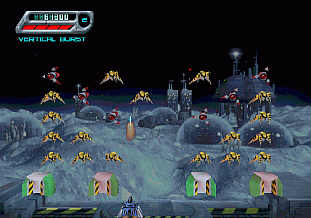 By the time the Playstation and
Nintendo 64 were introduced, Taito didn't have much of a presence in
the United States. Instead of releasing their own games here,
they left that responsibility to American distributors like
Acclaim. On occasion, they'd even grant companies a license to
create their own versions of classic Taito
games.
By the time the Playstation and
Nintendo 64 were introduced, Taito didn't have much of a presence in
the United States. Instead of releasing their own games here,
they left that responsibility to American distributors like
Acclaim. On occasion, they'd even grant companies a license to
create their own versions of classic Taito
games.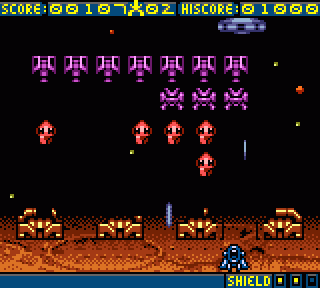 Take a good
look, boys and girls. This was one of the only good Game Boy
Color titles without the word "Pokemon" in the title.
Space Invaders was intended as a portable companion to the
remakes released on the N64 and Playstation, but this Game Boy Color
release is actually better than either of them!
Take a good
look, boys and girls. This was one of the only good Game Boy
Color titles without the word "Pokemon" in the title.
Space Invaders was intended as a portable companion to the
remakes released on the N64 and Playstation, but this Game Boy Color
release is actually better than either of them! Space Invaders says goodbye to
the 20th century with this portable conversion of the original
arcade game, released exclusively in Japan. The 16-bit power
of the Wonderswan makes this a little more impressive than the
first two Space Invaders ports on the Game Boy. The
system's horizontally oriented screen allowed Sunsoft to cram
all fifty five invaders onscreen at once, and the sound effects have
a bit more oomph to them than in previous portable
translations. The marching of the invaders is a little strange
(who left the vacuum on in front of the television?), but sounds
like the firing of your cannon and the deaths of the aliens are
right on target.
Space Invaders says goodbye to
the 20th century with this portable conversion of the original
arcade game, released exclusively in Japan. The 16-bit power
of the Wonderswan makes this a little more impressive than the
first two Space Invaders ports on the Game Boy. The
system's horizontally oriented screen allowed Sunsoft to cram
all fifty five invaders onscreen at once, and the sound effects have
a bit more oomph to them than in previous portable
translations. The marching of the invaders is a little strange
(who left the vacuum on in front of the television?), but sounds
like the firing of your cannon and the deaths of the aliens are
right on target.